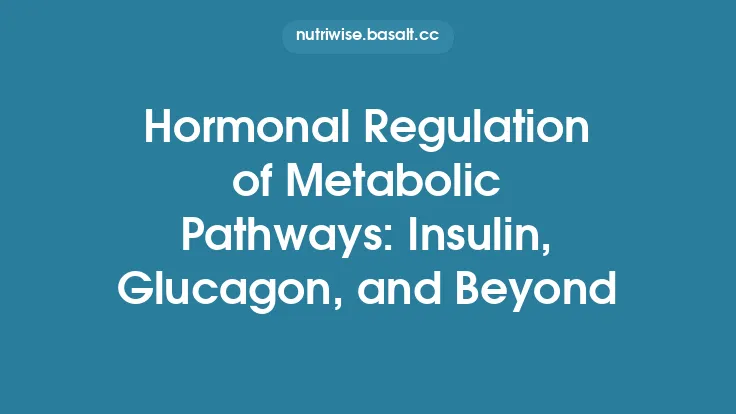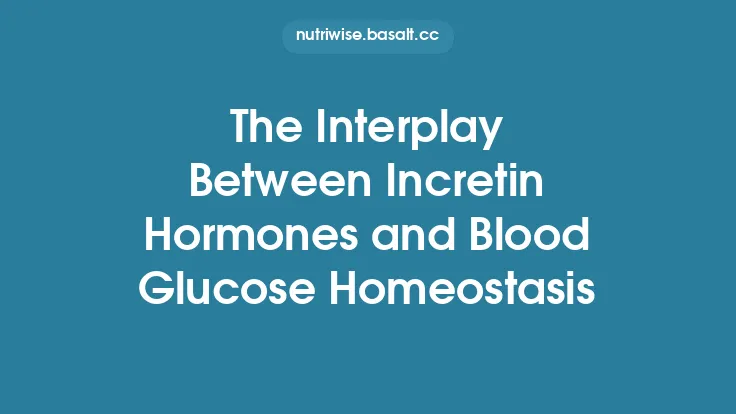Glucose‑Dependent Insulinotropic Polypeptide (GIP) is a 42‑amino‑acid peptide secreted by the enteroendocrine K‑cells of the proximal small intestine. Discovered in the 1970s, GIP was the first hormone identified with a clear insulin‑potentiating effect that is directly linked to the presence of nutrients in the gut lumen. Its ability to translate the chemical composition of a meal into a rapid, glucose‑dependent insulin response makes it a cornerstone of post‑prandial metabolic regulation. Understanding how GIP operates— from its synthesis and release to its receptor‑mediated signaling cascades—provides insight into the broader network of digestive hormones that coordinate nutrient handling and energy homeostasis.
Molecular Structure and Biosynthesis
GIP is synthesized as a pre‑prohormone (pre‑pro‑GIP) that undergoes co‑translational removal of a signal peptide, yielding pro‑GIP. Endoproteolytic cleavage by prohormone convertases (PC1/3 and PC2) generates the mature 42‑residue peptide. The primary sequence contains a conserved N‑terminal region critical for receptor activation; even a single amino‑acid substitution at position 2 (e.g., Ala→Gly) dramatically reduces its potency. Post‑translational amidation of the C‑terminus further stabilizes the molecule and enhances receptor affinity.
The GIP gene (GIP) is located on chromosome 17q21.2 in humans and is expressed almost exclusively in K‑cells, a specialized subset of enteroendocrine cells that line the duodenum and proximal jejunum. Transcriptional regulation involves a network of transcription factors such as Neurogenin‑3, Pax6, and the homeodomain protein Nkx2‑2, which together orchestrate the differentiation of K‑cells during intestinal development.
Nutrient Sensing and GIP Secretion
Glucose as the Primary Trigger
When glucose concentrations in the intestinal lumen rise after a carbohydrate‑rich meal, glucose is transported into K‑cells via the sodium‑glucose cotransporter 1 (SGLT1). The resulting depolarization opens voltage‑gated calcium channels, leading to an influx of Ca²⁺ that drives exocytosis of GIP‑containing granules. The glucose‑dependent nature of this process is underscored by the fact that GIP release is markedly attenuated when glucose absorption is pharmacologically blocked (e.g., by phloridzin).
Lipids and Fatty Acid Sensing
Long‑chain fatty acids (LCFAs) also stimulate GIP secretion, albeit through distinct mechanisms. GPR120 (FFAR4) and GPR40 (FFAR1), both G‑protein‑coupled receptors expressed on K‑cells, detect LCFAs and trigger intracellular signaling cascades involving phospholipase C (PLC) and diacylglycerol (DAG). The resultant rise in intracellular Ca²⁺ synergizes with glucose‑induced depolarization, amplifying GIP release.
Protein‑Derived Peptides
Amino acids and small peptides can modestly augment GIP secretion, primarily via the calcium‑sensing receptor (CaSR) and the peptide transporter PEPT1. However, their contribution is generally secondary to that of carbohydrates and fats, reflecting the evolutionary priority of glucose as an immediate energy source.
Hormonal and Neural Modulation
Enteric neurons releasing vasoactive intestinal peptide (VIP) and cholinergic inputs can potentiate GIP release through cAMP‑dependent pathways. Conversely, somatostatin, acting via somatostatin receptor subtype 2 (SSTR2), exerts an inhibitory tone, ensuring that GIP secretion does not exceed physiological limits.
Receptor Signaling Pathways
GIP exerts its actions by binding to the GIP receptor (GIPR), a class B G‑protein‑coupled receptor predominantly expressed on pancreatic β‑cells, but also present on adipocytes, osteoblasts, and certain neuronal populations. The receptor couples to multiple G‑protein subtypes, leading to a spectrum of intracellular responses.
Gαs‑Mediated cAMP Production
The canonical pathway involves Gαs activation, stimulating adenylate cyclase and raising intracellular cyclic AMP (cAMP). Elevated cAMP activates protein kinase A (PKA) and exchange protein directly activated by cAMP (Epac2). Both kinases phosphorylate key components of the insulin secretory machinery, such as the voltage‑dependent calcium channel (VDCC) and the exocytotic SNARE complex, thereby enhancing glucose‑stimulated insulin secretion (GSIS).
Gαq/11 and Phospholipase C
In certain cell types, GIPR also couples to Gαq/11, activating PLCβ, which hydrolyzes phosphatidylinositol‑4,5‑bisphosphate (PIP₂) into inositol‑1,4,5‑trisphosphate (IP₃) and DAG. IP₃ mobilizes Ca²⁺ from endoplasmic reticulum stores, while DAG activates protein kinase C (PKC). This calcium surge synergizes with cAMP‑driven pathways to further potentiate insulin granule exocytosis.
β‑Arrestin Recruitment and Signal Bias
Recent structural studies reveal that GIPR can recruit β‑arrestins, leading to receptor internalization and activation of MAPK/ERK pathways. This “biased signaling” may influence β‑cell proliferation and survival, suggesting that GIP’s actions extend beyond acute insulin release to longer‑term β‑cell health.
Physiological Effects on Pancreatic β‑Cells
Amplification of Glucose‑Stimulated Insulin Secretion
GIP’s hallmark function is to amplify insulin secretion in a glucose‑dependent manner. When plasma glucose exceeds the β‑cell threshold (~5 mM), GIP’s cAMP‑mediated signaling augments the insulin secretory response without triggering secretion at low glucose levels, thereby preserving euglycemia.
β‑Cell Proliferation and Survival
Chronic exposure to GIP, particularly in the context of nutrient excess, has been shown to activate the PI3K/Akt pathway, promoting β‑cell proliferation and inhibiting apoptosis. In rodent models, GIP administration mitigates β‑cell loss induced by streptozotocin, highlighting a potential trophic role.
Modulation of Gene Expression
cAMP response element‑binding protein (CREB) phosphorylation downstream of GIPR signaling up‑regulates genes involved in insulin biosynthesis (e.g., INS, PDX1) and glucose metabolism (e.g., GLUT2). This transcriptional reprogramming ensures that β‑cells are primed for sustained insulin output during repeated meals.
Interaction with Other Metabolic Tissues
Adipose Tissue
GIPR is expressed on both white and brown adipocytes. In white adipose tissue, GIP promotes lipogenesis by enhancing the activity of acetyl‑CoA carboxylase (ACC) and fatty acid synthase (FAS) via cAMP‑dependent pathways. In brown adipose tissue, GIP can stimulate thermogenic gene expression (UCP1) through β‑arrestin‑mediated MAPK activation, linking nutrient intake to energy expenditure.
Bone
Osteoblasts express functional GIPR, and GIP signaling stimulates bone formation by increasing alkaline phosphatase activity and collagen type I synthesis. This bone‑anabolic effect may represent an evolutionary adaptation to allocate nutrients toward skeletal growth during periods of abundant feeding.
Central Nervous System
Although the primary focus of GIP is peripheral, GIPR is present in hypothalamic nuclei involved in glucose sensing. Intracerebroventricular administration of GIP in rodents modestly reduces hepatic glucose production, suggesting a neuroendocrine feedback loop that fine‑tunes systemic glucose balance.
Regulation of GIP Activity and Degradation
Dipeptidyl Peptidase‑4 (DPP‑4) Cleavage
Circulating GIP is rapidly inactivated by the serine protease DPP‑4, which removes the N‑terminal dipeptide (His¹‑Ala²), converting active GIP(1‑42) into the less potent GIP(3‑42). The half‑life of native GIP in plasma is approximately 5–7 minutes, underscoring the importance of DPP‑4 in shaping its physiological profile.
Endogenous Inhibitors and Binding Proteins
Plasma proteins such as α‑2‑macroglobulin can bind GIP, modestly extending its half‑life. Additionally, the gut microbiota influences GIP degradation indirectly by modulating DPP‑4 expression in the intestinal epithelium.
Receptor Desensitization
Prolonged exposure to high GIP concentrations leads to GIPR phosphorylation by G‑protein‑coupled receptor kinases (GRKs) and subsequent β‑arrestin recruitment, resulting in receptor internalization. This desensitization mechanism is particularly relevant in the context of chronic overnutrition, where sustained GIP elevation may blunt its insulinotropic efficacy.
Clinical Implications and Therapeutic Developments
GIP Resistance in Type 2 Diabetes
Patients with type 2 diabetes (T2D) often exhibit a blunted insulinotropic response to GIP, a phenomenon termed “GIP resistance.” Contributing factors include down‑regulation of GIPR on β‑cells, chronic hyperglycemia‑induced receptor desensitization, and elevated DPP‑4 activity. Understanding the molecular basis of this resistance is a focal point of current research.
Dual Incretin Agonists
Pharmacological strategies have emerged that combine GIPR agonism with GLP‑1R activation (e.g., tirzepatide). These dual agonists exploit the complementary actions of the two incretins: GLP‑1 provides robust glucose‑lowering and appetite‑suppressing effects, while GIP contributes to enhanced insulin secretion and adipose tissue remodeling. Clinical trials have demonstrated superior glycemic control and weight reduction compared with GLP‑1 monotherapy, highlighting the therapeutic potential of harnessing GIP pathways.
GIPR Antagonists
Conversely, selective GIPR antagonists are being investigated for obesity treatment. By blocking GIP‑mediated lipogenesis in adipose tissue, these agents aim to reduce fat accumulation without compromising insulin secretion, especially when combined with GLP‑1R agonists.
Biomarker Applications
Circulating GIP levels, measured in fasting and post‑prandial states, serve as biomarkers for β‑cell function and dietary carbohydrate handling. Elevated post‑prandial GIP may indicate heightened nutrient absorption efficiency, whereas attenuated responses could signal early β‑cell dysfunction.
Research Frontiers and Emerging Insights
- Structural Biology of GIPR – Cryo‑EM studies have resolved the active conformation of GIPR bound to GIP and a G‑protein heterotrimer, revealing unique extracellular loop interactions that dictate ligand specificity. These insights guide the rational design of biased agonists that preferentially activate β‑cell proliferative pathways while minimizing lipogenic effects.
- Microbiome‑GIP Axis – Metagenomic analyses suggest that short‑chain fatty acid‑producing bacteria modulate GIP secretion via GPR41/43 signaling on K‑cells. Manipulating gut microbial composition could therefore fine‑tune GIP dynamics and improve post‑prandial insulin responses.
- GIP in Non‑Alimentary Contexts – Emerging data indicate that GIP may influence cardiovascular physiology by acting on GIPR expressed in endothelial cells, promoting nitric oxide production and vasodilation. This vasoprotective role is under investigation for its relevance to diabetic macrovascular complications.
- Gene Editing Approaches – CRISPR‑mediated up‑regulation of GIPR in β‑cells is being explored as a strategy to restore GIP sensitivity in diabetic models, offering a potential avenue for durable metabolic correction.
Summary and Key Takeaways
- Origin and Release: GIP is produced by K‑cells in the proximal small intestine and released in response to glucose, fatty acids, and, to a lesser extent, amino acids. Its secretion is tightly coupled to nutrient absorption via SGLT1, GPR120/40, and CaSR pathways.
- Receptor Signaling: Binding to the GIPR activates Gαs‑cAMP/PKA/Epac2 and, in some contexts, Gαq/11‑PLC‑Ca²⁺ pathways. β‑Arrestin recruitment adds a layer of biased signaling that can influence β‑cell growth.
- Metabolic Actions: The primary physiological role of GIP is to amplify glucose‑dependent insulin secretion, while also promoting β‑cell proliferation, adipose tissue lipogenesis, bone formation, and modest central effects on hepatic glucose output.
- Regulation: Rapid inactivation by DPP‑4, receptor desensitization, and modulation by neural and hormonal inputs ensure that GIP activity remains transient and proportional to nutrient intake.
- Clinical Relevance: GIP resistance characterizes T2D, but dual GIP/GLP‑1 agonists have demonstrated superior therapeutic outcomes. Conversely, GIPR antagonism is being pursued for obesity management.
- Future Directions: Structural elucidation of GIPR, microbiome interactions, cardiovascular effects, and gene‑editing strategies represent vibrant research frontiers poised to expand our understanding of GIP’s multifaceted role in human physiology.
Through its precise sensing of ingested nutrients and rapid translation into an insulinotropic signal, GIP exemplifies the elegant coordination between the digestive tract and endocrine pancreas. Continued investigation of its mechanisms promises not only deeper insight into normal metabolic regulation but also novel avenues for treating metabolic disease.





